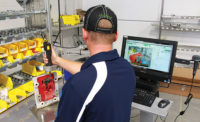Automakers spend a lot of time focusing on noise, vibration and harshness (NVH). That’s because many consumers demand vehicles that are as quiet as possible.
Operating conditions and frequency ranges typically vary by vehicle. For instance, luxury coupes are traditionally much quieter than compact hatchbacks.
“NVH is something that we can all identify with,” says Chi La, business unit director for gasoline and alternative fuels at IAV Automotive Engineering Inc. “It gives us immediate response to how a vehicle performs. When you step into a luxury sedan, you don’t expect to have the same sensory experience as you would in a sports car.”
Potential noise culprits in all vehicles include doors, emission systems, engines, fans, HVAC systems, instrument panels, seats, suspensions, tires, transmissions, windows and seats. Acoustic disturbances can also be generated by many other components, such as engine and transmission mounts, headliners, mufflers, oil and water pumps, prop shafts, rear axle differentials, steering yokes and tailpipes.
Automotive engineers try to tackle those challenges by using various types of insulation and sound dampening materials, such as foam or sealants, wherever possible. Things like acoustic glass, door seals and foam inserts within the body structure can help address basic NVH issues.
In addition, pressure-sensitive tape and structural adhesives are popular alternatives to nuts, bolts and other fasteners that can cause vibration-related disturbances.
Automobile frames are a common source of pesky squeaks, rattles and buzzes.
“Lightweight materials, such as aluminum and high-strength steel, have helped engineers create chassis and body structures that are now much stiffer than in the past,” says La. “That increased rigidity helps reduce primary noise. It also helps with secondary ride characteristics, which refers to harshness and noise caused by small imperfections in road surfaces.
“On the power train side, automakers are adopting more materials that have higher amounts of internal sound dampening,” explains La. “Things like cast aluminum oil pans are being replaced with carbon-fiber composite components. Magnesium covers are replacing stamped steel covers.”
However, reduction in weight can have an adverse effect on NVH performance. This is due to having less mass and inertia to react to forces. Lighter designs may also compromise structural performance.
Today, interior and exterior acoustics are becoming more important than ever. The age-old battle against squeaks and rattles is ramping up as the auto industry becomes increasingly electrified.
Theoretically, replacing traditional internal combustion engines with an electric power train means that noise and vibration levels will be reduced. But, in reality, the loss of traditional engine-masking sound can expose other noise issues that were previously not apparent to motorists.
Electric motors also generate noise and vibration, and electrical architectures require additional actuators and components that have unique NVH issues.
“They all have their own particular acoustic characteristics and, in some cases, lead to new effects,” says Bernd Findeisen, Ph.D., head of the NVH and mechanics, dynamics and simulation department at IAV. “Under load, for example, electric motors produce a typical whine not familiar from the combustion engine.
“The challenges become particularly complex when combustion engines and electric motors are used side by side in hybrid power trains,” adds Findeisen. “Wherever possible, occupants must not be allowed to notice when the combustion engine cuts in or shuts down. And during particularly quiet, all-electric operation, hitherto inaudible noises must be kept out of the passenger compartment, such as air, wind, rolling or transmission-related noises.”
As the auto industry evolves toward fully autonomous vehicles, NVH will take on even more importance.
“When people are no longer in control of vehicles, NVH may need to be further refined through engineering and the use of new materials,” says La. “Active noise control may take on added importance. For instance, the audio system could emit a sound that cancels out any objectionable noise issues.”







